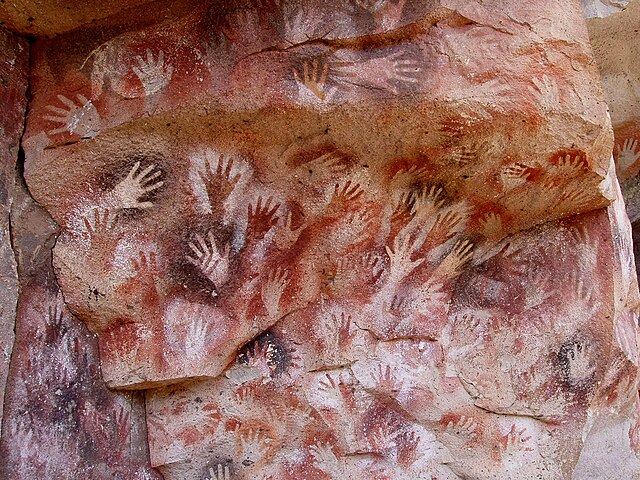In archaeology, rock art is human-made markings placed on natural surfaces, typically vertical stone surfaces. A high proportion of surviving historic and prehistoric rock art is found in caves or partly enclosed rock shelters; this type also may be called cave art or parietal art. A global phenomenon, rock art is found in many culturally diverse regions of the world. It has been produced in many contexts throughout human history. In terms of technique, the four main groups are:cave paintings,
petroglyphs, which are carved or scratched into the rock surface,
sculpted rock reliefs, and
geoglyphs, which are formed on the ground.
Reclining Buddha at Gal Vihara, Sri Lanka, where the remains of two columns to support the structure that originally enclosed it is visible
Nanabozho pictograph, Mazinaw Rock, Bon Echo Provincial Park, Ontario, Canada
Buddhist stone carvings at Ili River, Kazakhstan
Aboriginal rock painting of Mimi spirits in the Anbangbang gallery at Nourlangie Rock in Kakadu National Park.
In archaeology, cave paintings are a type of parietal art, found on the wall or ceilings of caves. The term usually implies prehistoric origin. These paintings were often created by Homo sapiens, but also Denisovans and Neanderthals; other species in the same Homo genus. Discussion around prehistoric art is important in understanding the history of the Homo sapiens species and how Homo sapiens have come to have unique abstract thoughts. Some point to these prehistoric paintings as possible examples of creativity, spirituality, and sentimental thinking in prehistoric humans.
Cueva de las Manos, Perito Moreno, Argentina. The art in the cave is dated between 7,300 BC and 700 AD; stenciled, mostly left hands are shown.
One of the oldest known figurative paintings, a depiction of an unknown bovine, was discovered in the Lubang Jeriji Saléh cave and dated to be more than 40,000 (perhaps as old as 52,000) years old.
An artistic depiction of a group of rhinoceros was completed in the Chauvet Cave 30,000 to 32,000 years ago.
Prehistoric cave painting of animals at Albarracín, Teruel, Spain (rock art of the Iberian Mediterranean Basin)








